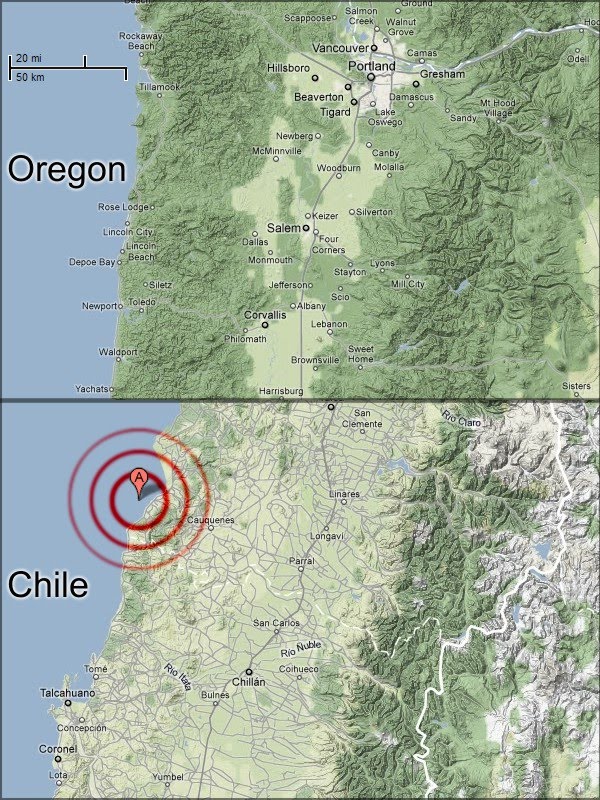The Geology behind Chile’s Earthquake hits close to home
With the news of damage from the 8.8 magnitude Chilean Earthquake still coming in, many news outlets (both locally and nationally) are bringing up the point that the same thing could happen here. In fact, the Oregon/Washington area is the most tectonically similar to Chile.  Both coasts lay on top of a subduction zone (Oregon’s is pictured), in which one plate is pushed below another. In our case, the Juan de Fuca plate is being pushed below the North American plate. This has two noticable impacts on the landscape by creating the coast range of smaller mountains from crust being pushed up, and the second impact of inland deep stress ‘sweating’ with lighter magma coming to the surface as the larger Cascades range.
Both coasts lay on top of a subduction zone (Oregon’s is pictured), in which one plate is pushed below another. In our case, the Juan de Fuca plate is being pushed below the North American plate. This has two noticable impacts on the landscape by creating the coast range of smaller mountains from crust being pushed up, and the second impact of inland deep stress ‘sweating’ with lighter magma coming to the surface as the larger Cascades range.
 For Chile, replace the names ‘Juan de Fuca’ with ‘Nazca’ and ‘North American’ with ‘South America’, and you can see that the Andes mountains have much in common with our Cascades range. To the right I have created a terrain comparison using the same scale and with the Chilean earthquake center noted. Geologists predict that around the year 1700, the Pacific Northwest had a 9.0 magnitude earthquake which was primarily documented in Japan, that received a devestating tsunami as a result. A 9.0 earthquake is roughly twice as powerful as the quake that struck Chile, and 1,000 times as powerful as the one that hit Haiti. It is worth note that the Chilean subduction zone is moving at roughly four times the rate, however our area is due to have one of these intense earthquakes sometime in the near future.
For Chile, replace the names ‘Juan de Fuca’ with ‘Nazca’ and ‘North American’ with ‘South America’, and you can see that the Andes mountains have much in common with our Cascades range. To the right I have created a terrain comparison using the same scale and with the Chilean earthquake center noted. Geologists predict that around the year 1700, the Pacific Northwest had a 9.0 magnitude earthquake which was primarily documented in Japan, that received a devestating tsunami as a result. A 9.0 earthquake is roughly twice as powerful as the quake that struck Chile, and 1,000 times as powerful as the one that hit Haiti. It is worth note that the Chilean subduction zone is moving at roughly four times the rate, however our area is due to have one of these intense earthquakes sometime in the near future.
This is another great reminder to prepare. The Oregon Red Cross has resources online for Earthquake and Tsunami preperation. Further, you can donate blood to help the area maintain a healthy blood supply to prepare for the uncertain future.
The Red Cross has already pledged an initial $50,000 towards relief for the earthquake.
Images:
Subduction diagram from the Oregon State capital 150 Million Years in the Making exhibit (for which I served on the creative team for)
Map created using assets from Google Maps
5 comments
Wow. Those map images are scarily similar. Nice post, Scott!
Thanks Lise! It was an interesting weekend for me- someone who grew up in Hawaii right next to a tsunami siren. The true lesson is that while Oregon hasen't had many major disasters in our history (we don't really get tornados or hurricanes), Oregon still has it's risks and we need to be prepared. Watching the Olympics last week, it was interesting to learn that Canada has a large national emergancy operations center (SitCen) in Ottawa that has been used for events like 9/11, however was originally constructed specifically to manage operations for when the big West Coast quake hits.
Please bare with me I'm new at this. I will become familiar with posting soon meanwhile. Portland is earthquake country. Three different types of earthquakes are possible in Oregon with two creating big threats for Portland. One is movement on local faults in the Portland area like the Portland Hills Fault. The other is the “Big One’ that could generate a magnitude of 9 along the coast and could last three minutes. Portland would be greatly affected by both.
Dr. Burns will talk about the sources of these quakes and their past history and future chances and specifically will talk about both Haiti and Chile and their relevance to Oregon. Chile is a perfect example of what could happen in Oregon with the Big One.
Wednesday March 10th 7:00pm-9:00pm
St. Francis Dining Hall
1182 SE Pine St.
Portland, OR
You are quite right! The diagram I included has little explosion marks for the different types of earthquakes that happen in the Pacific Northwest. The largest one is the 'Subduction Earthquake', which is what struck Chile and has the potential to be that 9.0. You also mentioned the 'Crustal Earthquakes', generated by the fault lines that Portland is on top of. Crustal quakes tend to be smaller and take the form of those 4 to 5 magnitude rumbles we tend to feel once every other year or so. It is important to note that if the 'big' quake were to occur these fault lines are likely places for aftershocks, similar to what Chile is now facing and in themselves magnitudes larger than typical Crustal quakes.
I found an interesting article regarding ten most devastating earthquakes and their rankings. Check out this site: http://www.onlinecolleges.net/2010/03/12/10-most-devastating-earthquakes-of-all-time/
Comments are closed.